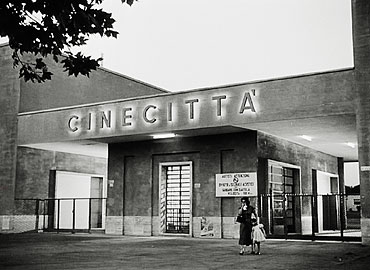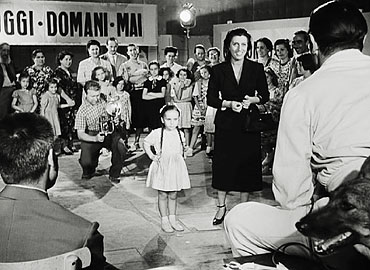 |
 |
| Film stills of Bellissima (Visconti) Anna Magnani and daugther |
Bellissima takes up again Tina Bara and Alba D'Urbano's interest in the social imprinting of individuals and in their biographical inscription, both in relation to their bodies and to the environment that shapes them. In this instance, the focus is the theme of "beauty" (bellezza) and the transfer of socially recognized canons and patterns of behavior from generation to generation.
At the center of the project, which also involves a biographical dimension, is the mother-daughter relationship. Both the content and the title of this project relate them to a film bearing the same name, directed by Luchino Visconti in 1951, which qualifies as one of the first instances of an artistic work taking the form of a self-reflexive critique of the media. In the Italy of the 1950s, when World War II had only recently ended and people still lived in poverty, the cinema presented itself not only as a "dream factory," but also as a privileged locus for achieving enhanced social status. The action of the film Bellissima consists of the process of casting a film, one that ultimately remains unrealized, as well as the background action of these events. Competing on the set for a better future are children, which is to say, girls. By means of this subject, Visconti explores the transformations engendered by the contemporary dissemination of cinema, with all of its myths, both in terms of social levels and individual biographies. He visualizes the norms that are the basis for the construction of a mediatized beauty, norms rooted in the masses in an earlier age. He tries to come to terms with the mechanisms of "moviemaking," displaying the inconsistencies inherent in the ideas and ethics of the media world. Today the media and television primarily fulfill the function of visualizing and transporting ideals of beauty within various social strata. The politics of the mediatized body generate a tendency toward standardized images of the body and normalized modes of behavior.The reference to Visconti’s film enables Bara and D’Urbano to measure their distance from the time of its production, and to reflect today on the transformations affecting their understanding of the body and of patterns of behavior.
This project, which is still in process, includes a series of photographs and videos, to be presented in various installations, which revolve around different facets of the theme.  Politecnico and
Politecnico and  Schwebender Ring are diveloped in two different countries and two different cultures especially concernig the theme of "beauty".
Schwebender Ring are diveloped in two different countries and two different cultures especially concernig the theme of "beauty".